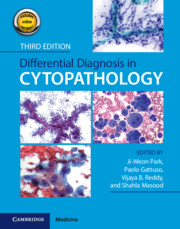Book contents
- Differential Diagnosis in Cytopathology
- Differential Diagnosis in Cytopathology
- Copyright page
- Dedication
- Contents
- Contributors
- Preface
- 1 The Pap Smear
- 2 Exfoliative Pulmonary Cytology
- 3 Body Cavity Fluids
- 4 Gastrointestinal Tract
- 5 Urinary Cytology
- 6 Cerebrospinal Fluid and Intraocular Cytology
- 7 Cytopathology of Central Nervous System
- 8 Fine-Needle Aspiration of Thyroid Gland
- 9 Parathyroid Gland, Head, and Neck
- 10 Salivary Glands
- 11 Cytopathology of the Breast
- 12 Fine-Needle Aspiration of Lymph Nodes
- 13 Fine-Needle Aspiration of Lung, Pleura, and Mediastinum
- 14 Fine-Needle Aspiration of Liver
- 15 Fine-Needle Aspiration of the Pancreas
- 16 Fine-Needle Aspiration of Soft Tissue and Bone
- 17 Fine-Needle Aspiration of the Kidney and Adrenal Gland
- 18 Cytology of the Gonads
- 19 Fine-Needle Aspiration Cytology of Tumors of Unknown Origin
- Index
- References
10 - Salivary Glands
Published online by Cambridge University Press: 05 March 2021
- Differential Diagnosis in Cytopathology
- Differential Diagnosis in Cytopathology
- Copyright page
- Dedication
- Contents
- Contributors
- Preface
- 1 The Pap Smear
- 2 Exfoliative Pulmonary Cytology
- 3 Body Cavity Fluids
- 4 Gastrointestinal Tract
- 5 Urinary Cytology
- 6 Cerebrospinal Fluid and Intraocular Cytology
- 7 Cytopathology of Central Nervous System
- 8 Fine-Needle Aspiration of Thyroid Gland
- 9 Parathyroid Gland, Head, and Neck
- 10 Salivary Glands
- 11 Cytopathology of the Breast
- 12 Fine-Needle Aspiration of Lymph Nodes
- 13 Fine-Needle Aspiration of Lung, Pleura, and Mediastinum
- 14 Fine-Needle Aspiration of Liver
- 15 Fine-Needle Aspiration of the Pancreas
- 16 Fine-Needle Aspiration of Soft Tissue and Bone
- 17 Fine-Needle Aspiration of the Kidney and Adrenal Gland
- 18 Cytology of the Gonads
- 19 Fine-Needle Aspiration Cytology of Tumors of Unknown Origin
- Index
- References
Summary
The majority of salivary gland lesions are benign. However, the lack of uniform reporting among institutions and the morphologic overlap, diversity, and heterogeneity of salivary gland neoplasms (due to cellularity, patterns, subtypes, and metaplastic changes) sometimes result in inconclusive, nonreproducible, descriptive diagnosis, thereby limiting the value of fine needle aspiration biopsy (FNAB). The Milan system for reporting salivary gland cytopathology (MSRSGC), a six-tiered evidence and risk based international consensus diagnostic classification, was first established in Milan, Italy, during the 2015 annual meeting of the European Cytology Congress. It aimed to standardize the nomenclature, to include ancillary techniques, to provide a risk of malignancy (ROM) for each category, and to guide clinical management in correlation with contrast enhanced CT or MRI findings.
- Type
- Chapter
- Information
- Differential Diagnosis in Cytopathology , pp. 304 - 339Publisher: Cambridge University PressPrint publication year: 2021



